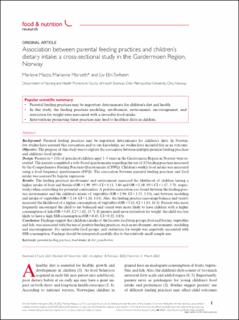Association between parental feeding practices and children’s dietary intake: a cross-sectional study in the Gardermoen Region, Norway
Peer reviewed, Journal article
Published version
Permanent lenke
https://hdl.handle.net/11250/3009698Utgivelsesdato
2022-03-31Metadata
Vis full innførselSamlinger
Originalversjon
https://doi.org/10.29219/fnr.v66.8050Sammendrag
Background: Parental feeding practices may be important determinants for children’s diets. In Norway,
few studies have assessed this association and to our knowledge, no studies have included fish as an outcome.
Objective: The purpose of this study was to explore the association between multiple parental feeding practices and children’s food intake.
Design: Parents (n=111) of preschool children aged 1–5 years in the Gardermoen Region in Norway were recruited. The parents completed a web–based questionnaire regarding the use of 12 feeding practices measured by the Comprehensive Feeding Practices Questionnaire (CFPQ). Children’s weekly food intake was measured using a food frequency questionnaire (FFQ). The association between parental feeding practices and food intake was assessed by logistic regression.
Results: The feeding practices involvement and environment increased the likelihood of children having a higher intake of fruit and berries (OR=1.99, 95% CI=1.15, 3.44 and OR=2.10, 95% CI=1.17, 3.78, respectively) when controlling for potential confounders. A positive association was found between the feeding practice environment and the children’s intake of vegetables (OR=2.94, CI=1.55, 5.55), and between modeling and intake of vegetables (OR=2.14, CI=1.26, 3.63). Also, the feeding practice encourage balance and variety increased the likelihood of a higher consumption of vegetables (OR=5.18, CI=1.63, 16.5). Parents who more frequently encouraged the child to eat balanced and varied were more likely to have children with a higher consumption of fish (OR=5.03, CI=1.62, 15.7). If parents used more restriction for weight, the child was less likely to have a high SSB consumption (OR=0.43, CI=0.22, 0.83).
Conclusion: Findings suggest that children’s intake of the favorite food item groups, fruit and berries, vegetables and fish, was associated with the use of positive feeding practices, such as involvement, environment, modeling and encouragement. For unfavorable food groups, only restriction for weight was negatively associated with SSB consumption. Findings should be interpreted carefully due to the relatively small sample size.

